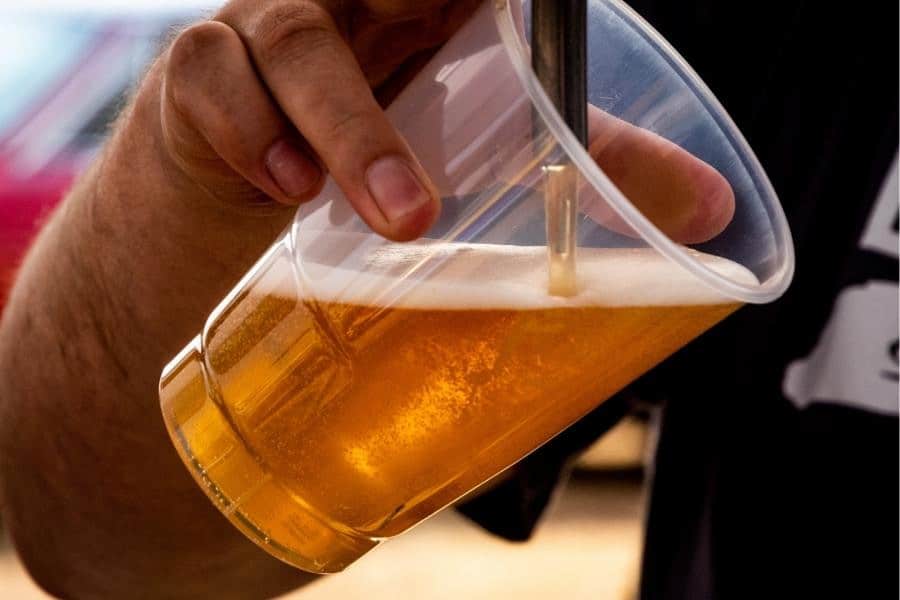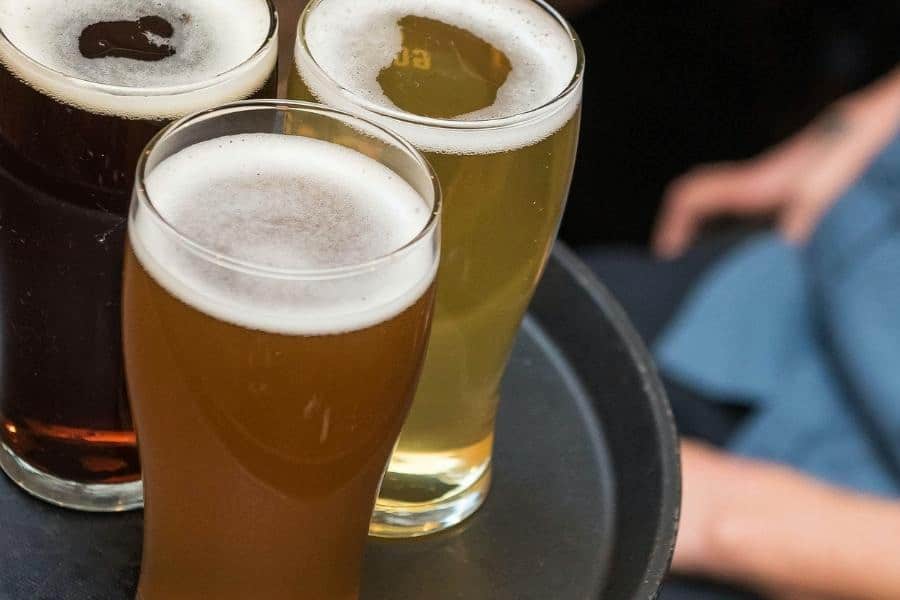If you buy something through a link in our posts, we may get a small share of the sale.
Every brewer needs to know how to calculate ABV from gravity readings. This is because ABV (alcohol by volume) is the most commonly cited statistic when referring to a beer’s strength. It is also a good indicator of how much fermentation has occurred and how the beer will taste.
Contents
How to Calculate ABV From Gravity
To calculate ABV from gravity, measure your wort’s original gravity (OG) and final gravity (FG) using a hydrometer. Next, subtract the FG number from the OG number to determine the difference in gravity points. Finally, use an ABV calculator to convert the gravity points into percent alcohol by volume.

Original gravity (OG) is a reading taken just before yeast is added or pitched. It is also a measure of the wort’s density and can be used to calculate the beer’s ABV. Final gravity (FG), on the other hand, is a measure of the beer’s density after fermentation is complete. You need a hydrometer to take these readings to get an accurate number.
If you don’t have the ABV calculator, you can use ABV = (OG – FG) x 131.25 to calculate the alcohol by volume. Figure 131.25 is the conversion factor that incorporates the relative density of alcohol and water. To get the result, ensure you have your readings in Specific Gravity format.
Simple Steps on Calculating ABV From Gravity
Understanding alcohol by volume (ABV) is essential to nailing your recipes as a homebrewer. While ABV is commonly printed on commercial beer labels, you’ll need to calculate it yourself as a homebrewer. Here’s a quick guide to calculating ABV from gravity readings:
Assemble Your Equipment
Of course, before calculating ABV, you need to gather a few pieces of equipment to help you take accurate gravity readings. These items include:
- Hydrometer: A hydrometer is a glass instrument used to measure a liquid’s density. It’s essential for taking both original and final gravity readings.
- Sanitized Sample Jar: You’ll need a clean, sanitized jar to collect your wort or beer sample for hydrometer readings.
- Brewing Notebook: A brewing notebook is a great way to keep track of your recipes, brewing process, and results. In it, you can record your original and final gravity readings for future reference.
- ABV Calculator: While you can calculate ABV without one, using an ABV calculator will save you time and energy.
Take Gravity Readings
Now that you have all the equipment you need, it’s time to take your gravity readings. These readings are crucial to calculating ABV, so be sure to take them accurately. Here’s how to take an OG reading:
- Sanitize your hydrometer and sample jar with a no-rinse sanitizer.
- Fill your sample jar with 10-12 ounces of wort or beer.
- Insert the hydrometer into the wort or beer and give it a spin to get rid of any bubbles clinging to the sides.
- Take a reading at the point where the surface of the liquid intersects with the scale on the hydrometer.
- Record this number in your brewing notebook.

To take a final gravity reading, first ensure the wort or beer has finished fermenting. Then, follow the same steps as of original gravity. Just be sure to take the reading from the fermented wort or beer instead of the unfermented wort.
Calculate ABV
Now that you have your OG and FG readings, it’s time to calculate ABV. To do so, simply subtract your FG reading from your OG reading. This number is your gravity point. For example, if your wort had an OG of 1.055 and an FG of 1.012, the gravity points would be 0.043.
Now that you have your gravity points use an ABV calculator or the formula ABV = (OG – FG) x 131.25 to determine your beer’s alcohol by volume using an ABV calculator or from the formula. For example, if your wort had an OG of 1.055 and an FG of 1.012, the ABV would be (1.055 – 1.012) x 131.25 = 5.64% ABV.
As a general rule of thumb, most commercial beers have an alcohol by volume of 4-12%. However, the rule has exceptions since some beers can have an ABV as high as 67.5%. For instance, the world’s strongest beer is Snake Venom, which has an ABV of 67.5%.
Troubleshooting Common Problems
While calculating ABV from gravity is a relatively simple process, there are a few things that can go wrong. Here are a few tips for troubleshooting common problems:
- Incorrect hydrometer reading: If your hydrometer reading is incorrect, your ABV will be off as well. To avoid this, be sure to take your reading to the point where the surface of the liquid intersects with the scale on the hydrometer. Also, be sure to take your reading from a sample that’s been properly mixed and is at the correct temperature.
- Incorrect calculator input: Be sure to enter the correct numbers into your ABV calculator. Remember, OG is different from FG. If you enter the wrong number, your calculation will be off.
- Improperly sanitized equipment: If your equipment isn’t properly sanitized, it could affect your gravity readings. To avoid this, sanitize your hydrometer and sample jar with a no-rinse sanitizer before taking your readings.
- Incorrect wort or beer sample: It’s important to take your gravity readings from a representative sample of the wort or beer. Otherwise, your ABV calculation will be off. To get a representative sample, simply take a small sample from multiple points in the wort or beer. Then, mix these samples together before taking your gravity reading.
- Wrong formula: Remember, the formula for ABV is different from the one for ABW. Be sure to use the correct formula when calculating ABV from gravity.
Benefits of Knowing How to Calculate ABV
Whether you’re a homebrewer or simply enjoy trying new beers, it’s helpful to know the alcohol by volume of the beers you’re drinking. The following are a few benefits of knowing how to calculate ABV:
- Helps you track your alcohol consumption and calorie intake.
- It helps you choose beers that match your taste preferences.
- Allows you to compare the alcohol content of different beers.
- Helpful for pregnant women and people with medical conditions that limit alcohol consumption.
- Allows you to calculate how much alcohol is in a particular batch of homebrew.

Frequently Asked Questions
How Does ABV Relate to Specific Gravity?
ABV is directly related to specific gravity. In fact, you need to know both your gravity before fermentation (OG) and your gravity after fermentation (FG) to calculate ABV. This way, you can determine how much sugar in your wort has been converted to alcohol.
How Can I Lower the ABV of My Beer?
There are a few ways to lower the ABV of your beer. One way is to add more water to your wort before fermentation. This will dilute your wort’s sugar and alcohol content, resulting in a lower ABV. Another way to lower ABV is to add a non-fermentable sugar, such as lactose, to your wort. This will increase the gravity of your wort without increasing the alcohol content.
Is There Any Way to Increase the ABV of My Beer?
Yes, there are a few ways to increase the ABV of your beer. One way is to use a higher-gravity wort. This will give your yeast more sugar to ferment, resulting in higher alcohol content. Another way to increase ABV is to add fermentable sugars, such as honey or molasses, to your wort. This will also increase the gravity of your wort and the alcohol content.
Conclusion
Calculating your beer’s ABV is a simple process that can be done at home with a few tools and some basic knowledge. By understanding how to calculate ABV, you can better track your alcohol consumption, choose beers that match your taste preferences, and even make adjustments to your homebrew recipes.

